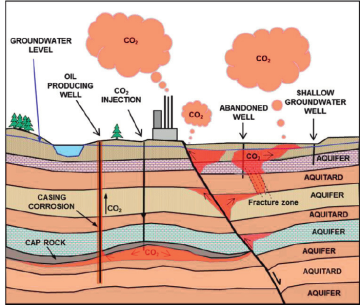Geological carbon storage (GCS) is the injection of carbon dioxide (CO2) deeply underground into carefully selected geological formations for long-term containment. It has been touted as one way to greatly mitigate global warming.
While GCS holds promise, it also raises questions and concerns around safety. Members of the communities living above these proposed storage sites, seem to have one question: “Is GCS truly safe?”
This article examines the safety of GCS by addressing common concerns, presenting evidence-based assessments, and exploring the actual measures in place to ensure its secure and responsible deployment.
To understand the safety of GCS, we must first grasp its fundamental principles and the geological context in which it operates. GCS involves capturing CO2, primarily from large industrial emitters like power plants and factories, and then transporting it to a suitable geological formation where it is injected deep underground for permanent storage.
The process generally follows three main steps.
Capture: In the capture phase, CO2 is separated from other captured gases in industrial flue gas streams using various technologies, including pre- and post-combustion capture, oxy-fuel combustion, etc.
Transport: The captured CO2 is compressed and then transported via pipelines or ships, to the storage site.
Storage: The captured CO2 is injected through wells into specific rock formations thousands of meters below the earth's surface.
An important factor to the safety and effectiveness of GCS is the selection of appropriate geological formations for CO2 storage. Ideal storage sites possess specific characteristics that allow them to safely contain CO2 for geological timescales.
The primary types of geological formations usually considered for CO2 storage include:
Saline aquifers. Vast, porous rock formations saturated with highly saline water that is unfit for human consumption or agriculture. They represent the largest potential storage resource of CO2 globally.
Depleted oil and gas reservoirs. Formations that have previously held oil and gas for long periods of time, which demonstrate their long-term sealing capabilities. The existing infrastructure from previous drilling can be repurposed to reduce development costs.
Unmineable coal seams. When CO2 is injected into deep coal seams, it adsorbs onto the coal matrix, potentially displacing methane.
Regardless of the type of formation, there are three primary mechanisms that ensure CO2 remains stored permanently, including:
Stratigraphic trapping. This is enforced by an impermeable caprock at the top of the formation, effectively preventing the upwards migration of CO2 back to the surface
Mineral trapping. The injected CO2 reacts with other minerals in the formation, leading to precipitation or dissolution, thereby trapping the CO2 permanently.
Residual trapping. When the buoyant CO2 is unable to overcome pressure required to exit a tight pore space, it gets trapped there.
Potential Risks and Concerns
Despite its important role in managing climate change, GCS naturally elicits concerns from the public and requires thorough technical evaluation. Risks associated with GCS revolve around the potential for CO2 to escape from the storage formation and its broader impacts on the subsurface and surface environment.
Induced Seismicity
Increased pore pressure from the injection of large volumes of CO2 can alter the stress state of existing faults, making them more prone to slip, and a potential risk for inducing seismic events like earthquakes. Proper site selection, avoiding active fault zones, and careful management of injection pressures are key to minimizing this risk.
CO2 Leakage
While multiple natural trapping mechanisms are at play, no system is entirely risk-free and leakages may still occur. The potential pathways for leakage include faults or fractures in caprock and wellbore integrity issues (Fig. 1).

CO2 leakage back to the surface would undermine the very purpose of GCS itself, thereby negating climate beliefs. Leakages also pose an asphyxiation risk to humans and animals in nearby areas and could impact local ecosystems by altering soil pH and affecting vegetation, which would be detrimental to agricultural practices.
Groundwater Contamination
Groundwater contamination, a serious risk associated with GCS, attracts significant concern. Contamination can occur through brine displacement, acidification of dissolved CO2 which lowers the pH of groundwater, or reaction of CO2-rich water with rock minerals which dissolve heavy metals and radioactive elements into the groundwater. Preventing this would require thorough hydrogeological characterization of all overlying aquifers and potential pathways.
Community Engagement, Trust, and Social License
Beyond technical and environmental risks, public perception and the achievement of a social license to operate are very critical for the execution of GCS projects. This requires deeply understanding and addressing the concerns of local communities, which often extend beyond technical safety.
Concerns voiced by residents, local officials, or Indigenous groups near proposed or operating GCS sites center on a range of issues—health and safety impacts, potential contamination of land and water resources, the integrity of their land rights, and broader quality of life impacts from construction and ongoing operations (e.g., heavy truck traffic, noise). It becomes obvious that the extent and quality of public consultation, or a perceived lack thereof, significantly shapes these community responses.
Recent situations have highlighted the power of community opposition when trust is absent or concerns are unaddressed. In 2023, pressure from local residents in South Dakota played a significant role in canceling a proposed 1,300-mile Navigator CO2 pipeline. In Queensland, Australia, farmers successfully blocked Glencore’s proposed CO2 storage project, citing a lack of meaningful community participation and insufficient geological review. These cases emphasize the fact that effective GCS cannot be deployed without full engagement, transparency, and trust with affected communities.
Regulatory Oversight and Best Practices
The GCS industry operates under increasingly stringent regulations and adheres to evolving best practices. These regulations are created and monitored by national and international regulatory bodies, independent regulatory agencies to provide oversight, ensure compliance, and continuous improvement in safety protocols. There are also measures and robust regulatory frameworks to ensure safety and minimize the risks associated with GCS.
Site selection and characterization, proper well design, and Monitoring, Reporting, and Verification (MRV) are just a few of these practices. There are also contingency plans in place to manage any instances of leakage and other emergencies, including immediate response protocols. All of these are applied across the entire lifecycle of a GCS project, and from initial planning to post-closure.
Successful GCS Projects With Strong Safety Records
The safety of GCS is not just a theoretical concept, but has been demonstrated by operational projects around the world. Several GCS projects have successfully stored millions of tonnes of CO2 over many years, and provide invaluable data that prove that the technology is viable.
- Sleipner CO2 Storage Project, Norway: This project has been operational since 1996, and is the world's longest-running offshore CO2 storage project. Equinor (formerly Statoil) injects CO2 into a deep saline aquifer (Utsira Formation) under the North Sea. Extensive seismic monitoring has consistently shown the CO2 plume behaving as predicted, with no evidence of leakage (Fig. 2).

Fig. 2—Project design for the Sleipner CO2 storage project. Source: Institute for Energy Economics and Financial Analysis - Snøhvit CO2 Storage Project, Norway: This offshore project has also been operated by Equinor since 2008. CO2 captured from natural gas production is injected into a sub-seafloor saline aquifer.
- Quest Carbon Capture and Storage Project, Canada: Operational since 2015, Quest captures CO2 from an oil sands upgrader and injects it into a deep saline aquifer in Alberta. The project has an extensive MRV program, including groundwater monitoring, seismic surveys, and remote sensing, all of which confirm secure containment.
Conclusion
GCS is a vital part of the global effort to combat climate change and presents a viable way to significantly reduce CO2 emissions from hard-to-abate industrial sources. However, it is not without its risks, which are quite serious and could potentially have serious adverse impacts on the environment, especially on communities situated close to these storage sites. Evidence from operational projects strongly suggest that, with proper site selection, robust engineering, comprehensive monitoring, and stringent regulatory oversight, GCS can be implemented safely and securely. The accumulated experience from operational projects like Sleipner, Snøhvit, and Quest demonstrates that CO2 can be injected and contained deep underground for long periods without adverse impacts on human health or the environment.
The deployment of this technology must always prioritize the safety and well-being of the communities in whose backyard these projects are being executed. This means striking a careful balance between embracing the climate benefits of GCS while upholding the highest standards of safety, transparency, and engagement within these communities. For GCS to fulfill its potential, continued investment in research and development, a commitment to transparent communication, and genuine engagement with local communities are a huge must. By doing this, we can ensure that geological carbon storage contributes effectively to a sustainable future and protects both our planet and our communities instead of harming them.
For Further Reading
The Development of a Leak Remediation Technology for Potential Non- Wellbore Related Leaks from CO2 Storage Sites by J. Byrdie, Natural Resources Canada, E. Perkins, Alberta Innovates, D. Fisher, et. al.
Norway’s Sleipner and Snøhvit CCS: Industry Models or Cautionary Tales? by G. Hauber, Institute for Energy Economics and Financial Analysis
Carbon Dioxide Capture and Sequestration: Overview, US Environmental Protection Agency
Carbon Capture and Storage: What Can We Learn From the Project Track Record? by T. Lockwood, Clean Air Task Force
Glencore's Australia Carbon Storage Project Blocked Because of Groundwater Risk by P. Hobson, Reuters


